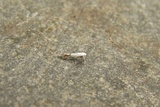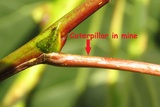Phyllocnistis extrematrix Martynova, 1955 Species
Last modified: Dec. 10, 2025, 6:20 p.m.
Discovered in Belgium only in 2018. This species was described from Kazakhstan, but during recent years, it might have spread toward W Europe (in 2014 it was recorded from the Czech Republic, France, Portugal, Slovakia, and Spain, and in 2017 it was recorded from Germany), but another possibility is that it has always been overlooked because of its resemblance with Ph. unipunctella.
Details
- Classification
- Family: Gracillariidae > Subfamily: Phyllocnistinae > Genus: Phyllocnistis > Species: Phyllocnistis extrematrix
- Vernacular names
- Peppeltwijgmineermot (NL), Pappelzweig-Schneckenmotte (DE)
- First mention in Belgium
- Steeman C. & Sierens T. 2019. Interessante waarnemingen van Lepidoptera in België in 2018 — Phegea 47(2): 53–63. On page 58 (as Phyllocnistis extrematrix Martynova, 1955). view page
- Status
-
Native
Distribution
Imago
Cannot be distinguished with certainty from Ph. unipunctella which lives on the same hostplant, therefore examination of the genitalia is necessary.
Mine
A long, serpentine gallery in the bark of young shoots, through the petiole, entering the leaf in the last instar stage and continuing its mine along the leaf margin.
See gracillariidae.net.
Bionomics
The egg is oviposited on a young shoot of the host plant.
The last instar enters a leaf via the petiole and folds a leaf margin downwards with spinning. Pupation under that folded leaf in a flimsy spinning.
The species probably hibernates in the adult stage.
Flight periods
Not known with certainty, but probably two generations a year in June–July and October–November.
Observed on
- Host plant (species):
- Populus nigra, Populus × canadensis, Populus balsamifera and Populus nigra var. italica
- Host plant (genera):
- Populus
The species lives on Populus trees. It has been described from Kazakhstan where it lived on Populus suaveolens. In W Europe it has been recorded on Populus nigra and its var. italica, but also on the related species P. x canadensis and P. balsamifera.






















